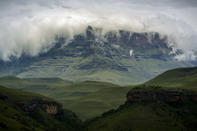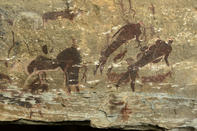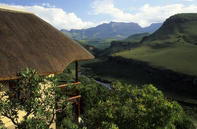Garden Castle
The name Giant's Castle was originally given to what we now call Garden Castle way to the south, by the 'insatiable' Captain AF Gardiner, Royal Navy. However, by the time the first map was made of the area, that name had been transferred to its present-day location (people say now because the ridge resembles a giant lying down, but that is not true.

As with Cathedral, it just got mixed up on early rough maps; it was a little known area then and very hard to map, with each person giving new names on each new map. The Zulu name for the ridge is either Bhulihawu, the 'shield thrasher', or Phosihawu, the 'shield flinger'. These poetic images refer to the storms which brew around its mighty precipices and are then flung out over the foothills like the shield of a supernatural impi.
Zulu people will not point a straight finger at the mountain, lest it unleash its terrible forces they use a crooked one. It would be appropriate if one of these more evocative and apt names came back into use because it simply does not resemble a castle.
Sheltering Bushmen

The first we know about the Giant's Castle area is from scant records about commandos chasing Bushmen into the passes of the area. Tragically ironic is that the last Bushman known to have lived and died in the Drakensberg were shot by such a commando just two decades prior to the declaration of the Giant's Castle Game Reserve.
It was only as late as the mid-20th century that Bushman culture was widely accepted as being of immense and its passing seen as a great loss. It was a brave and tenacious party of adventurers that set out from the Dargle in February 1864 to explore the Giant's Castle area, still sheltering Bushmen who would have been antagonistic and armed with poisoned arrows.
We know from the diary of surveyor Augustus Bovill that they located the Giant's Pass, climbed it and the Giant itself, and descended by another pass almost certainly the Hlathimba, on their 10-day exploration.
From War Came Good Maps
In 1873 the independent-minded amaHlubi chief Langalibalele, in the wake of the Zulu Wars, refused to acknowledge British gun and marriage laws (he had 80 wives) and started plotting open revolt. He had already had run-ins with Zulu King Mpande and British administrator Sir Theophilus Shepstone.
As the Colony of Natal felt seriously threatened all available troops were called up: British Army forces, six volunteer regiments and a ‘native' contingent. The plan was to encircle Langalibalele and prevent him escaping up the c into Lesotho, with as little fuss and loss of life as possible. However the poor maps available caused a complete botch-up of the plan and finally a full-scale engagement occurred.
Oh, the blunders. In the ensuing mélée led by Major AW Dumford, of his men were killed. Of course the recalcitrant chief was eventually brought to book, but this small incident had widespread repercussions in the colony.
One of it was that JE Fannin was commissioned to map the passes of that area properly, while Dumford (now colonel) and the 75th Regiment were sent out to blow up the final approaches Many years later, warden Roden Symons while he was out looking for the mysteriously vanished hiker Rev Bates, found numerous skeletons in the pass as evidence of the 'smoke on the pass', as the Langalibalele rebellion was called at the time.
Giant's Castle Game Reserve

In November 1903 Sydney Barnes - the first of three Barneses to fill the post of warden here - came trundling up the Bushman's River Valley in an ox wagon, and set up camp in a cave close to the larger cut-away which had once been a major refuge for Bushmen, and set about proclaiming his new kingdom as the domain of wild animals and wild mountains. 'No man could have lived a lonelier and more isolated life,' muses Reg Pearse, but at least he was being paid.
I reckon it was Eden. The purpose of Giant's Castle Game Reserve was to protect the dwindling herds of eland: the spur coming down from Giant's South Ridge is called Mpofana, the 'place of eland', and you are very likely to see them still there. But what of the other animals? In 1915 Philip Barnes took over. Predators killed 'royal game' so they were to be eliminated. Over 32 years Barnes shot 600 jackals, but I'm relieved to report that those wily creatures live on all over the Berg.
Others weren't so lucky: leopards, serval and caracal were all shot on sight and, although the two smaller species survive in unknown number, leopards not been seen for many years. In 1918 a hunting party set out to make 'one last determined effort to eradicate the menace' Of wild dogs that took refuge in Lesotho. A pack of 17, as well as one spotted hyena, were wiped out and none have been seen since. Nkenthsane, or ‘wild dog hill’, commemorates the event.
How modern conservators must shudder. Today the reserve is best known for its superb rest camp and restaurant (more suited to the pockets of foreign tourists than hikers, it must be said), and the Main Caves Bushman Rock Art Museum which was initiated by warden Bill Barnes in the 1960s. But birders and photographers vie for a chance to book a day at the famous Lammergeier Hide, where, in winter, carcasses are set out.
By David Bristow